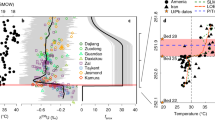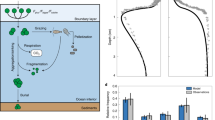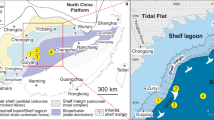Abstract
The Neoproterozoic era witnessed a succession of biological innovations that culminated in diverse animal body plans and behaviours during the Ediacaran–Cambrian radiations. Intriguingly, this interval is also marked by perturbations to the global carbon cycle, as evidenced by extreme fluctuations in climate and carbon isotopes. The Neoproterozoic isotope record has defied parsimonious explanation because sustained 12C-enrichment (low δ13C) in seawater seems to imply that substantially more oxygen was consumed by organic carbon oxidation than could possibly have been available. We propose a solution to this problem, in which carbon and oxygen cycles can maintain dynamic equilibrium during negative δ13C excursions when surplus oxidant is generated through bacterial reduction of sulfate that originates from evaporite weathering. Coupling of evaporite dissolution with pyrite burial drives a positive feedback loop whereby net oxidation of marine organic carbon can sustain greenhouse forcing of chemical weathering, nutrient input and ocean margin euxinia. Our proposed framework is particularly applicable to the late Ediacaran ‘Shuram’ isotope excursion that directly preceded the emergence of energetic metazoan metabolisms during the Ediacaran–Cambrian transition. Here we show that non-steady-state sulfate dynamics contributed to climate change, episodic ocean oxygenation and opportunistic radiations of aerobic life during the Neoproterozoic era.
This is a preview of subscription content, access via your institution
Access options
Access Nature and 54 other Nature Portfolio journals
Get Nature+, our best-value online-access subscription
$29.99 / 30 days
cancel any time
Subscribe to this journal
Receive 12 print issues and online access
$259.00 per year
only $21.58 per issue
Buy this article
- Purchase on Springer Link
- Instant access to full article PDF
Prices may be subject to local taxes which are calculated during checkout




Similar content being viewed by others
Data availability
The authors declare that data supporting the findings of this study are available within the article and Supplementary Information.
Code availability
MATLAB code for COPSE is freely available at https://github.com/sjdaines/COPSE/releases.
References
Lenton, T. M., Boyle, R. A., Poulton, S. W., Shields-Zhou, G. A. & Butterfield, N. J. Co-evolution of eukaryotes and ocean oxygenation in the Neoproterozoic era. Nat. Geosci. 7, 257–265 (2014).
Chen, X. et al. Rise to modern levels of ocean oxygenation coincided with the Cambrian radiation of animals. Nat. Commun. 6, 7142 (2015).
Rothman, D. H., Hayes, J. M. & Summons, R. E. Dynamics of the Neoproterozoic carbon cycle. Proc. Natl Acad. Sci. USA 100, 8124–8129 (2003).
Knoll, A. H., Hayes, J. M., Kaufman, aJ., Swett, K. & Lambert, I. B. Secular variation in carbon isotope ratios from Upper Proterozoic successions of Svalbard and East Greenland. Nature 321, 832–838 (1986).
Burns, S. J. & Matter, A. Carbon isotopic record of the latest Proterozoic from Oman. Eclogae Geol. Helv. 86, 595–607 (1993).
Kaufman, A. J., Knoll, A. H. & Narbonne, G. M. Isotopes, ice ages, and terminal Proterozoic Earth history. Proc. Natl Acad. Sci. USA 94, 6600–6605 (1997).
Calver, C. R. Isotope stratigraphy of the Ediacarian (Neoproterozoic III) of the Adelaide Rift Complex, Australia, and the overprint of water column stratification. Precambrian Res. 100, 121–150 (2000).
Melezhik, V., Fallick, A. E. & Pokrovsky, B. G. Enigmatic nature of thick sedimentary carbonates depleted in 13C beyond the canonical mantle value: the challenges to our understanding of the terrestrial carbon cycle. Precambrian Res. 137, 131–165 (2005).
Grotzinger, J. P., Fike, D. a. & Fischer, W. W. Enigmatic origin of the largest-known carbon isotope excursion in Earth’s history. Nat. Geosci. 4, 285–292 (2011).
Schrag, D. P., Higgins, J. A., Macdonald, F. A. & Johnston, D. T. Authigenic carbonate and the history of the global carbon cycle. Science 339, 540–543 (2013).
Li, Z. X. et al. Assembly, configuration, and break-up history of Rodinia: a synthesis. Precambrian Res. 160, 179–210 (2008).
Krissansen-Totton, J., Buick, R. & Catling, D. C. A statistical analysis of the carbon isotope record from the Archean to Phanerozoic and implications for the rise of oxygen. Am. J. Sci. 315, 275–316 (2015).
Fairchild, I. J. et al. Tonian–Cryogenian boundary sections of Argyll, Scotland. Precambrian Res. 319, 37–64 (2017).
McKirdy, D. M. et al. A chemostratigraphic overview of the late Cryogenian interglacial sequence in the Adelaide Fold-Thrust Belt, South Australia. Precambrian Res. 106, 149–186 (2001).
Rose, C. V. et al. Constraints on the origin and relative timing of the Trezona δ13C anomaly below the end-Cryogenian glaciation. Earth Planet. Sci. Lett. 319–320, 241–250 (2012).
Fike, D. A., Grotzinger, J. P., Pratt, L. M. & Summons, R. E. Oxidation of the Ediacaran ocean. Nature 444, 744–747 (2006).
Lu, M. et al. The DOUNCE event at the top of the Ediacaran Doushantuo Formation, South China: broad stratigraphic occurrence and non-diagenetic origin. Precambrian Res. 225, 86–109 (2013).
Condon, D. et al. U-Pb ages from the Neoproterozoic Doushantuo Formation, China. Science 308, 95–98 (2005).
Gong, Z., Kodama, K. P. & Li, Y. X. Rock magnetic cyclostratigraphy of the Doushantuo Formation, South China and its implications for the duration of the Shuram carbon isotope excursion. Precambrian Res. 289, 62–74 (2017).
Bristow, T. F. & Kennedy, M. J. Carbon isotope excursions and the oxidant budget of the Ediacaran atmosphere and ocean. Geology 36, 863–866 (2008).
Bjerrum, C. J. & Canfield, D. E. Towards a quantitative understanding of the late Neoproterozoic carbon cycle. Proc. Natl Acad. Sci. USA 108, 5542–5547 (2011).
Derry, L. A. A burial diagenesis origin for the Ediacaran Shuram-Wonoka carbon isotope anomaly. Earth Planet. Sci. Lett. 294, 152–162 (2010).
Li, C. et al. Uncovering the spatial heterogeneity of Ediacaran carbon cycling. Geobiology 15, 211–224 (2017).
Lee, C., Love, G. D., Fischer, W. W., Grotzinger, J. P. & Halverson, G. P. Marine organic matter cycling during the Ediacaran Shuram excursion. Geology 43, 1103–1106 (2015).
Garrels, R. M. & Lerman, A. Coupling of the sedimentary sulfur and carbon cycles - an improved model. Am. J. Sci. 284, 989–1007 (1984).
Burke, A. et al. Sulfur isotopes in rivers: insights into global weathering budgets, pyrite oxidation, and the modern sulfur cycle. Earth Planet. Sci. Lett. 496, 168–177 (2018).
Wortmann, U. G. & Paytan, A. Rapid variability of seawater chemistry over the past 130 million years. Science 337, 334–336 (2012).
Guilbaud, R., Poulton, S. W., Butterfield, N. J., Zhu, M. & Shields-Zhou, G. A. A global transition to ferruginous conditions in the early Neoproterozoic oceans. Nat. Geosci. 8, 466–470 (2015).
Lenton, T. M., Daines, S. J. & Mills, B. J. W. COPSE reloaded: an improved model of biogeochemical cycling over Phanerozoic time. Earth Sci. Rev. 178, 1–28 (2017).
Daines, S. J., Mills, B. J. W. & Lenton, T. M. Atmospheric oxygen regulation at low Proterozoic levels by incomplete oxidative weathering of sedimentary organic carbon. Nat. Commun. 8, 14379 (2017).
Canfield, D. E. & Farquhar, J. Animal evolution, bioturbation, and the sulfate concentration of the oceans. Proc. Natl Acad. Sci. USA 106, 8123–8127 (2009).
Osburn, M. R., Owens, J., Bergmann, K. D., Lyons, T. W. & Grotzinger, J. P. Dynamic changes in sulfate sulfur isotopes preceding the Ediacaran Shuram Excursion. Geochim. Cosmochim. Acta 170, 204–224 (2015).
Laakso, T. A. & Schrag, D. P. A small marine biosphere in the Proterozoic. Geobiology 388, 81–91 (2019).
Kendall, B. et al. Uranium and molybdenum isotope evidence for an episode of widespread ocean oxygenation during the late Ediacaran period. Geochim. Cosmochim. Acta 156, 173–193 (2015).
Shi, W. et al. Sulfur isotope evidence for transient marine-shelf oxidation during the Ediacaran Shuram Excursion. Geology 46, 267–270 (2018).
Campbell, I. H. & Squire, R. J. The mountains that triggered the Late Neoproterozoic increase in oxygen: the second Great Oxidation Event. Geochim. Cosmochim. Acta 74, 4187–4206 (2010).
Prince, J. K. G., Rainbird, R. H. & Wing, B. A. Evaporite deposition in the mid-Neoproterozoic as a driver for changes in seawater chemistry and the biogeochemical cycle of sulfur. Geology 47, 375–379 (2019).
Canfield, D. E., Poulton, S. W. & Narbonne, G. M. Late-Neoproterozoic deep-ocean oxygenation and the rise of animal life. Science 315, 92–95 (2007).
Sahoo, S. K. et al. Oceanic oxygenation events in the anoxic Ediacaran ocean. Geobiology 14, 457–468 (2016).
Saltzman, M. R. & Thomas, E. in The Geologic Time Scale (eds Gradstein, F. M. et al.) Ch. 11 (Elsevier, 2012).
Berner, R. A. GEOCARB II: a revised model of atmospheric CO2 over Phanerozoic time. Am. J. Sci. 294, 56–91 (1994).
Acknowledgements
This work was supported by the NERC-NSFC programme ‘Biosphere Evolution, Transitions and Resilience’ through grant NE/P013643/1 to G.A.S. and M.Z. and NE/P013651/1 to T.M.L., grant NE/R010129/1 to G.A.S. and B.J.W.M., a University of Leeds Academic Fellowship to B.J.W.M., and the National Natural Science Foundation of China (41661134048) and Strategic Priority Research Program (B) of the Chinese Academy of Sciences (XDB18000000) to M.Z.
Author information
Authors and Affiliations
Contributions
G.A.S., B.J.W.M. and M.Z. conceived the project. B.J.W.M. created the model, which was revised from previous versions created by T.M.L., B.J.W.M. and S.J.D. All authors contributed to data interpretation and the writing of the manuscript.
Corresponding authors
Ethics declarations
Competing interests
The authors declare no competing interests.
Additional information
Publisher’s note: Springer Nature remains neutral with regard to jurisdictional claims in published maps and institutional affiliations.
Supplementary information
Supplementary Information
Supplementary Information
Rights and permissions
About this article
Cite this article
Shields, G.A., Mills, B.J.W., Zhu, M. et al. Unique Neoproterozoic carbon isotope excursions sustained by coupled evaporite dissolution and pyrite burial. Nat. Geosci. 12, 823–827 (2019). https://doi.org/10.1038/s41561-019-0434-3
Received:
Accepted:
Published:
Issue Date:
DOI: https://doi.org/10.1038/s41561-019-0434-3
This article is cited by
-
Cryogenian and Ediacaran integrative stratigraphy, biotas, and paleogeographical evolution of the Qinghai-Tibetan Plateau and its surrounding areas
Science China Earth Sciences (2024)
-
Uncovering the Ediacaran phosphorus cycle
Nature (2023)
-
Sulfate triple-oxygen-isotope evidence confirming oceanic oxygenation 570 million years ago
Nature Communications (2023)
-
Spatiotemporal variation of dissolved oxygen in the Ediacaran surface ocean and its implication for oceanic carbon cycling
Science China Earth Sciences (2023)
-
Extensive primary production promoted the recovery of the Ediacaran Shuram excursion
Nature Communications (2022)



